


Welcome to this latest edition of Workbench and all the news, updates and exclusive announcements from the fascinating world of Airfix modelling.
Over recent editions, it appears as if the new generation of Airfix Product Designers have been taking over blog proceedings somewhat, as we have showcased their many talents on several of the most recent new model project announcements. We are delighted to say that in this 123rd edition, one of them will be taking centre stage once more, as we bring you an early development detail review from the last remaining new model tooling announcement from the 2020 range, the stunning 1/48th scale Canadair Sabre Mk.4.
In addition to the collection of exclusive images supporting the feature above, we also have further images marking the recent release of a scale version of arguably one of the most distinctive individual aircraft to see service with the post war Royal Air Force, as well as seeing how some recent blog ‘stars’ are now flying onto modelling work stations all over the world. We will also be including a really interesting reader supplied build feature, which involves doing something to an Airfix kit that most of us would never dream of doing, as well as announcing the lucky winner of our latest competition.
We have another edition packed full of new Airfix modelling goodness for you, so let’s get started straight away.
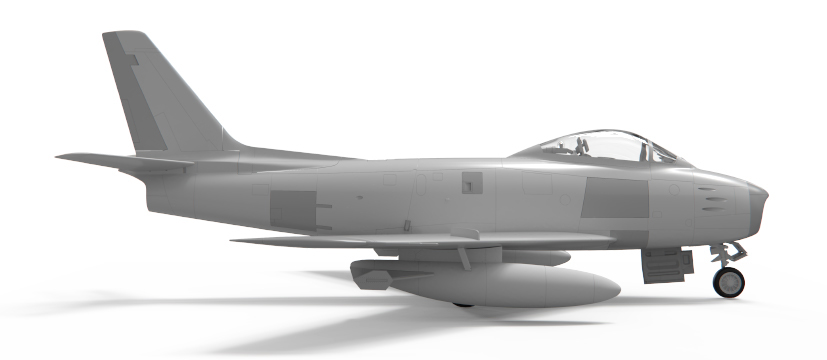
This new Canadair Sabre Mk.4 development feature is going to be littered with a great many exclusive images, including this CAD rendered image taken from the powerful design software used by this new kit’s designer
As the Second World War finally drew to a close, it was already clear that the future of aviation development would be powered by the jet engine and a seemingly never-ending quest for ever greater speeds. Germany had taken a significant lead in the field of jet powered aviation technology, with the Allied nations trailing in their wake by at least 12 months and despite the fact that the Royal Air Force did manage to introduce their jet powered Gloster Meteor fighter before the end of the war, they were reluctant to introduce it into combat on the continent, for fear of an example falling into enemy hands.
In America, military planners decided against pursuing jet technology during time of war, instead deciding to concentrate all their efforts on ensuring as many of the latest piston engined Mustangs could be produced and rushed to the world’s combat zones, aircraft which were proving so effective in strangling Axis air forces into submission. Inevitably, this decision would have an impact on America’s eventual entry into the jet age, but was a sacrifice the rest of the world were glad they made. When they eventually began work on an indigenous jet powered aviation programme, the first aircraft to take to the sky looked very similar to the aircraft which had just engaged in combat during WWII, with the obvious omission of a propeller. Whilst offering the greater speeds associated with jet power, early American jet aircraft such as the Bell P-59 Airacomet, Lockheed P-80 Shooting Star and Republic F-84 Thunderjet all featured the straight wing designs associated with aircraft which fought throughout the Second World War.
As their famous P-51 Mustang was widely regarded as the finest single engined fighter of the war, it will come as no surprise that the design team at North American Aviation were quick to turn their attention to producing a new jet powered fighter once the war had ended. Their initial design had like previous US jets, incorporated a straight wing design, however, having been given access to captured German research data, changed their design to feature a wing which was swept back by 35%. Determined that their new aircraft would be capable of attaining great speeds, their design also incorporated a beautifully streamlined fuselage and retained the exceptional pilot visibility first introduced on the ‘D’ variant of the successful Mustang.

Another computer rendered 3D image which represents many months of work for Tom Alderman, one of the new breed of Airfix product designers who are making their mark on the hobby
With three nose mounted .50 calibre machine guns positioned on either side of the aircraft’s front fuselage, the new North American F-86 Sabre shared much of the design philosophies incorporated in its famous piston engined predecessor - beautiful to look at, but a deadly fighting aeroplane at heart.
The first flight of the XP-86 prototype aircraft took place on 1st October 1947 and on what must have been a big day for everyone at North American, they were fortunate that they could rely on the skills of one of America’s greatest aviators on this auspicious occasion. North American’s chief test pilot at that time was none other than George Welsh, WWII fighter ace and national hero, a man who had famously piloted his Curtiss P-40 fighter against the attacking Japanese aircraft during the Pearl Harbor raid, becoming one of the first US aviators to score aerial victories in WWII (even though war against Japan was not officially declared until the following day).
Later in the aircraft’s development programme, an F-86A Sabre would go on to set a new world airspeed record of 670.84 mph, underlining the credentials of this important new fighter and bringing it to the attention of the aviation world. On entering service with the U.S Air Force in 1949, the North American F-86 Sabre would have the distinction of not only being America’s first swept wing fighter, but also the fastest fighter aircraft in the world. It would go on to be regarded as one of the most important aircraft in the post war jet era and arguably the most capable of the world’s early jet designs.
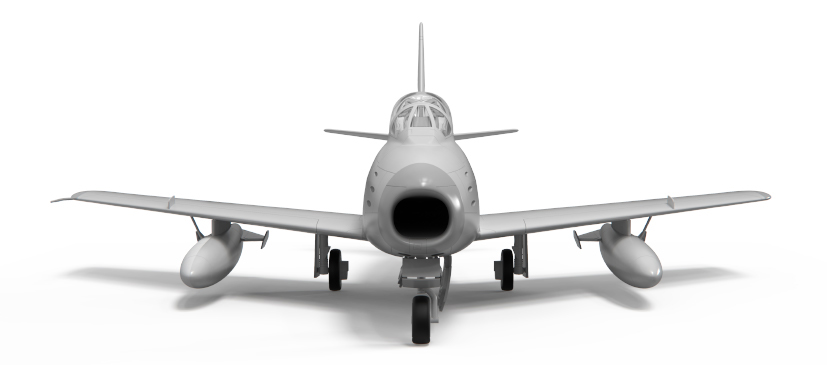
What a profile – the F-86 Sabre has to be regarded as one of the most important jet fighters of the post war era
When you think about it, we do ask quite a lot of the small but highly talented product designer team here at Airfix. Not only do we ask them to work in a high profile and highly specialised area (outside of the Airfix design team, no other product designers in the country have this unique skill set), but we also ask them to take on projects which result in scale kit representations of some of the world’s most famous aircraft and vehicles, machines which are familiar to many millions of people. Working under such pressures as these, it is no wonder that blog readers have become totally fascinated in hearing how the team attack their latest modelling projects.
Another one of our relatively recent product design recruits, Workbench readers are already familiar with the design expertise of Thomas Alderman, as we have brought you several features looking at his work on new projects such as the 1/48th scale de Havilland Tiger Moth and on another classic early jet fighter, the Mikoyan-Gurevich MiG-17F. As is the nature with this kind of work, even while Tom was giving us details of the latest design project we were covering for the blog, he will have no doubt been back-tracking somewhat, as he will already be working on his latest project, one which for the time being would be under a strict information embargo. In fact, as he was telling us about his work on the MiG-17, he was probably aware that a future project for him would be the North American (Canadair) Sabre, if he had not already started it.
When Tom and the other designers are about to embark on their latest project, they are usually handed a robust research file by our Lead Researcher for them to refer to, whilst at the same time being given the opportunity to spend some time completely immersing themselves in the aircraft or vehicle they are about to work on. We have an extensive reference library in our Margate offices which has been built up over the years and in conjunction with the robust research files and the internet, there will certainly be no shortage of information available to the designer.
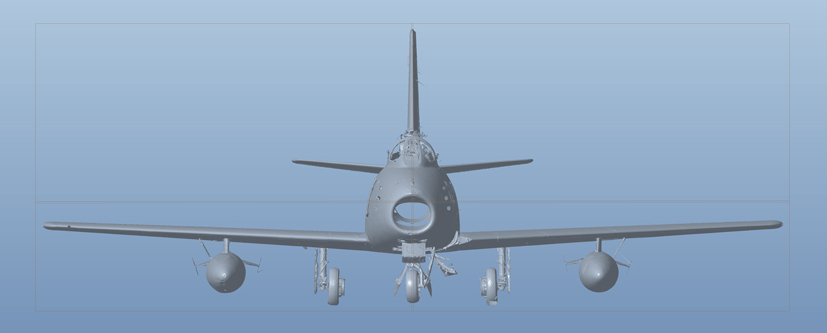
Workbench readers like nothing more than seeing exclusive development images from the latest model tooling projects and this next selection of images feature scan data from the new Sabre project, files which were crucial to designer Tom when embarking on this project
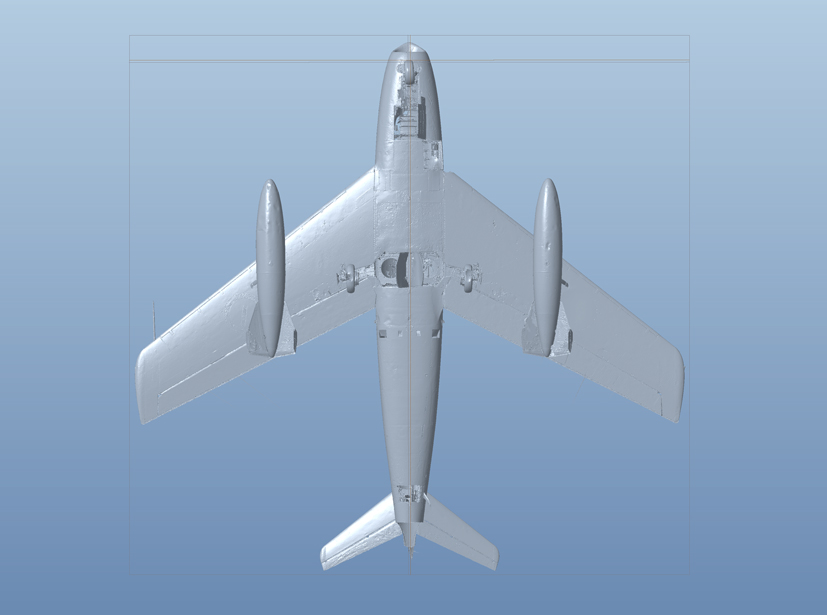
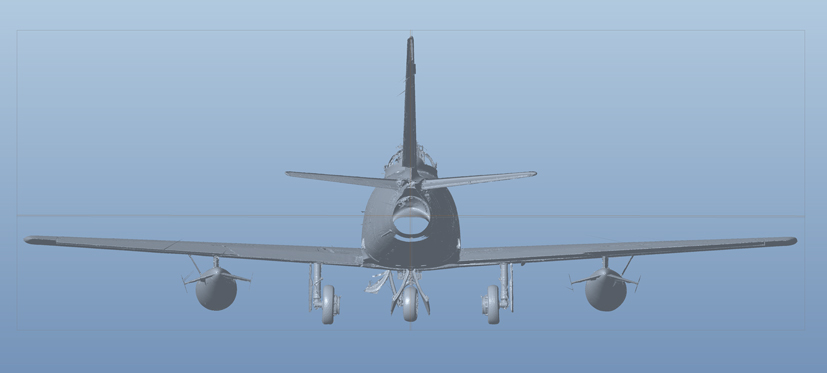
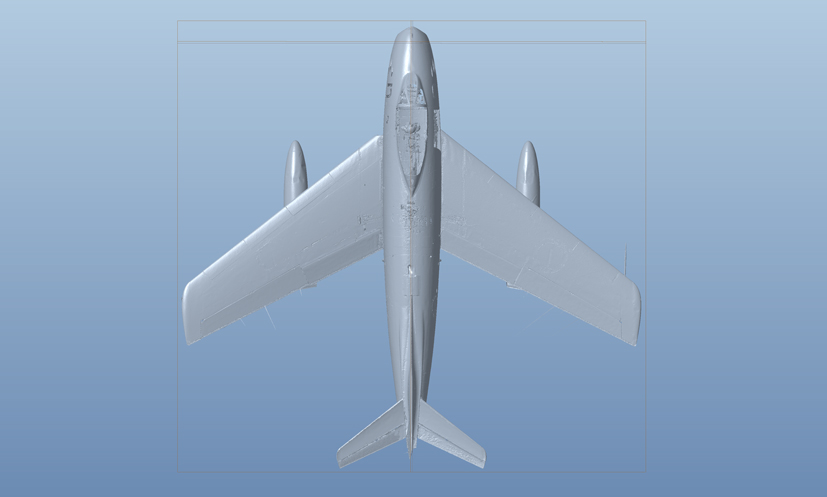
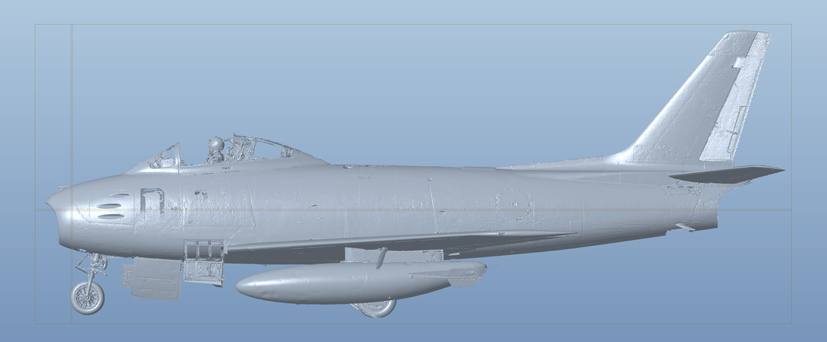
Having just completed work on another classic early jet fighter, Tom would be following up his MiG-15 design by taking on the equally famous North American F-86 Sabre, this time in the larger 1/48th scale. At the start of the project, he knew he had accurate LIDAR scan data to refer to, as our Lead Researcher had arranged to scan a suitable aircraft on a recent trip to the Norwegian Armed Forces Aircraft Collection in Oslo. Although Tom was not present during the original scanning trip, he did travel to Oslo on a follow up research trip, where he was given the opportunity to take measurements and detailed photographs of the aircraft, whilst already working in the design phase. Interestingly, if you look at the exclusive selection of scan images featured above you will note that they include a pilot figure, something which is highly unusual. Tom described how the Sabre in Oslo is displayed with a pilot figure in the cockpit, which did create something of a challenge when trying to obtain all his cockpit reference measurements.
Although the ability to scan a subject aircraft or vehicle is clearly going to be a great help to the Airfix product designers at the start of any project, it is by no means essential. In some cases, it is not always possible to obtain scanned data in support of a new project, which maybe down to reasons of general scan accessibility, its geographic location or simply the fact that a suitable scan subject may not actually exist. In these cases, access to design drawings and previous reference files will be more than adequate, with our talented designers having a number of clever tricks up their sleeves to allow them to get where they need to be.
With regard to the new Sabre kit, despite having access to scan data, Tom had to look into the history of this particular aircraft to discover whether all the information contained within the scan files would actually be an accurate representation of the variant to be modelled. With surviving historic aircraft now a relatively scarce commodity, it is important for him to know at the outset if the scanned aircraft differs in any way from the version/versions of the aircraft he will be designing in scale model form. This could include any damage which the airframe has suffered, anything which was incorporated in the restoration of the aircraft which was ‘non-standard’ and indeed any components which are on the exhibit which would not have been on the service version of Sabre he will be producing. This could highlight areas of the scan data which would need to be ignored or modified as his design work progresses.

This next selection of images show various base model screenshots from the Sabre project. These illustrate how the converted scan shape data is used as a starting point for developing all the individual components of the new model. This type of view is referred to as a skeletal detail image and shows the breakdown of individual areas which will be requiring the designer’s attentions over the coming weeks
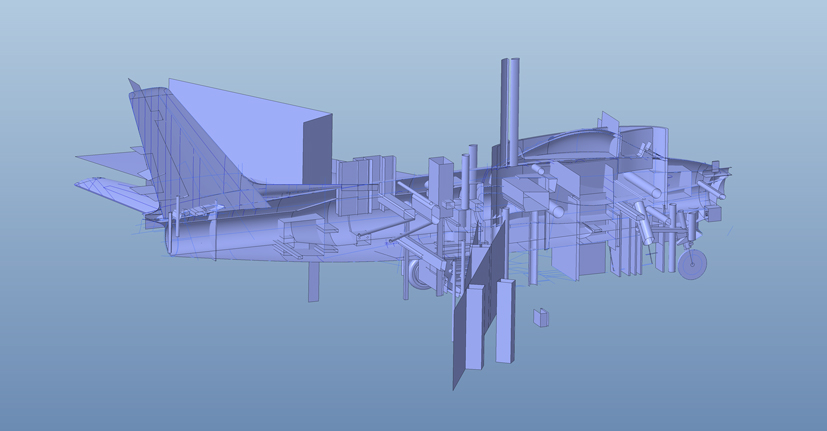
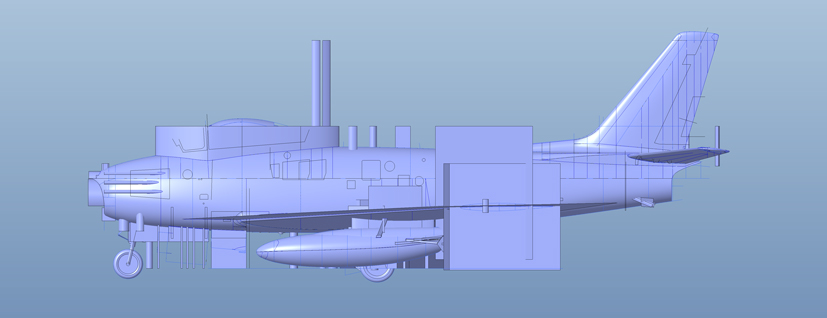
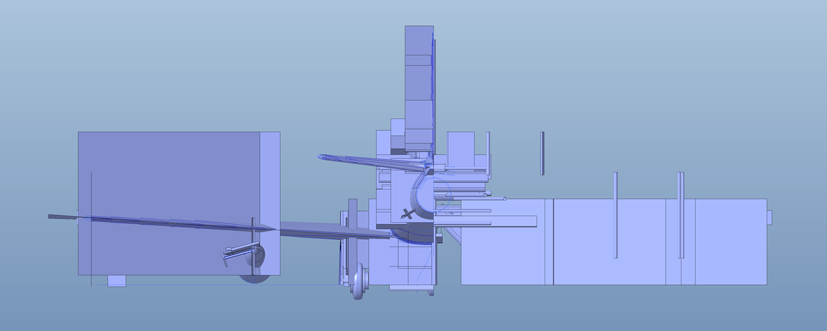
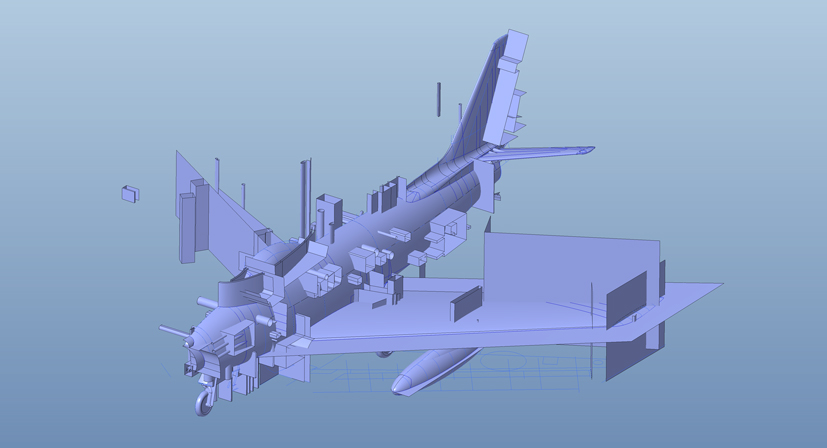
Although producing incredibly accurate shape information of the subject aircraft, the LIDAR scan data only represents the starting point of the project for the designer and over the course of the next few months, he is in for an extremely busy period of Sabre indulgence. The scan files are clearly not in a format which could be recognised by the CNC milling machines which will eventually be used to produce the model tooling blocks and in any case, the iconic shape of the aircraft will now have to be broken down into individual components of a model kit. This will require time, patience, attention to detail and a huge amount of skill and by the end of it, the designer will probably be so sick of the project that they will be desperate to move on to the next one.
Using the LIDAR scan as a hollow outline, Tom can now create a 3D CAD version of the information, which will serve as a base model shell and allow the further design of the individual component parts necessary in the production of a modern model kit. All this information is contained within a huge master file, which is referred to as an ‘Assembly Model’ and will include the scan data, base or skeleton model, surfacing detail and indeed the individual product design sections, once produced. Although this all sounds incredibly impressive, this information is of little use until worked and deciphered by the unique skill set of one of the Airfix product designers.
From experience, Tom will have a good idea how he intends to break the new kit into its component parts, using the wealth of research and scan information to hand and wherever possible, following the internal construction splits used during manufacture of the real aircraft. This can be quite straightforward for major modelling components such as fuselage and wing halves, but is clearly much more challenging when looking at other, more intricate sections of the kit. At all times, he will be aware of the limitations of the injection moulding process and the scale thicknesses he is able to work with, but will also be keen to incorporate as much fine detail as he possibly can.

Whilst discussing the Sabre project with Tom, it was interesting to note that many of the design challenges he faced with this project were similar to those he experienced whilst working on the earlier Mikoyan-Gurevich MiG-17F kit. We always like to ask our designers 'Which aspects of the project posed the most problems and which are you most pleased with?' and they seemed to be almost identical on both of these projects. Shapes and geometry appear to be the things that cause designers the most headaches, particularly around the front air intake and rear jetpipe, iconic shapes on both of these early jet aircraft. Perversely, these challenging design elements also tend to be the parts of the model the designers are most proud of.
On the new Sabre, a particularly challenging area of the design proved to be towards the rear of the aircraft, where the tail, rudder, horizontal stabilisers, elevators and jetpipe all converge. This complex combination of shapes, curves and geometric challenges would require many hours of concentration if they were to be translated accurately into scale kit form, with the resultant parts being thick enough to support the placement of panel and scribing detail, whilst at the same time possessing inherent rigidity and an accurate scale appearance. From the designers perspective, they see it as a success if all their efforts are rarely given a moments thought whilst modellers are enjoying building the kit they have worked on, once released, confident in the fact that if they have had an enjoyable modelling experience, they must have done something right at the design stage.
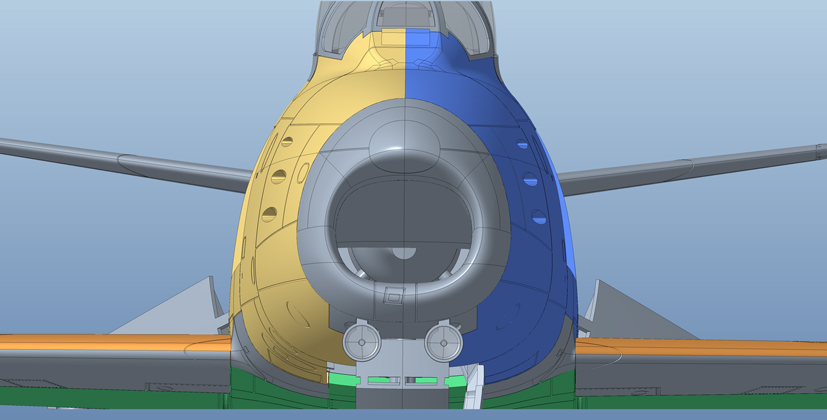
A further selection of fascinating CAD assembly screenshots taken from Tom’s computer whilst working on the Sabre project. The software is incredibly powerful and allows the designer to view and manipulate the project file data in so many ways, all of which will help him whilst working on the new kit and all of huge interest to Workbench readers. Tom has complete control over the appearance of how these screenshots look and can choose to use different colours to highlight joins and surfaces if required and even elect to reveal or conceal sections of the model’s construction
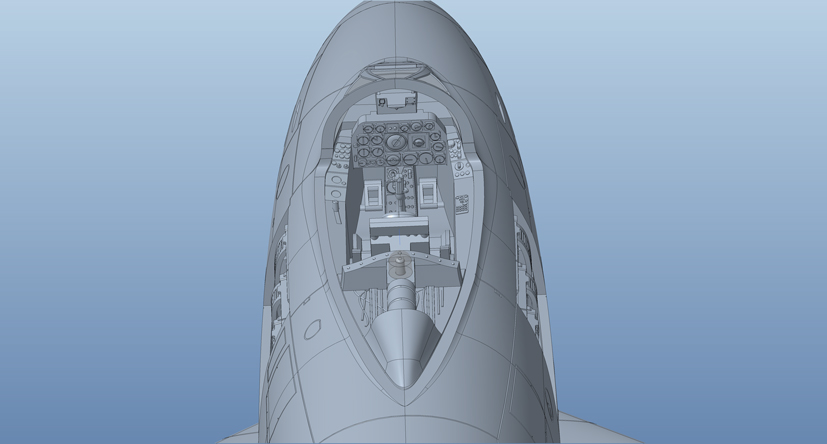
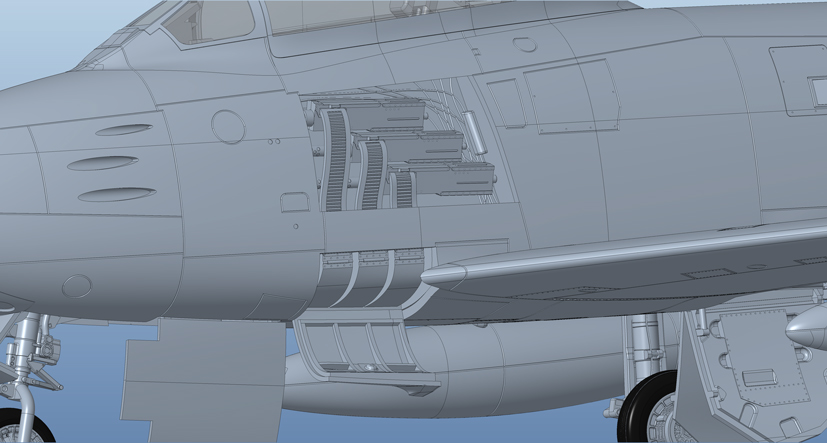
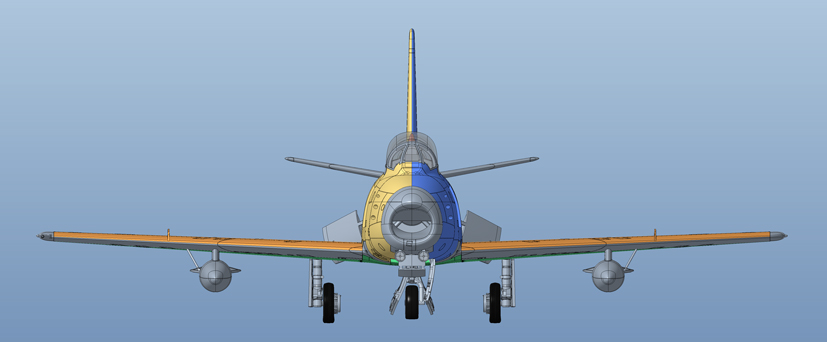
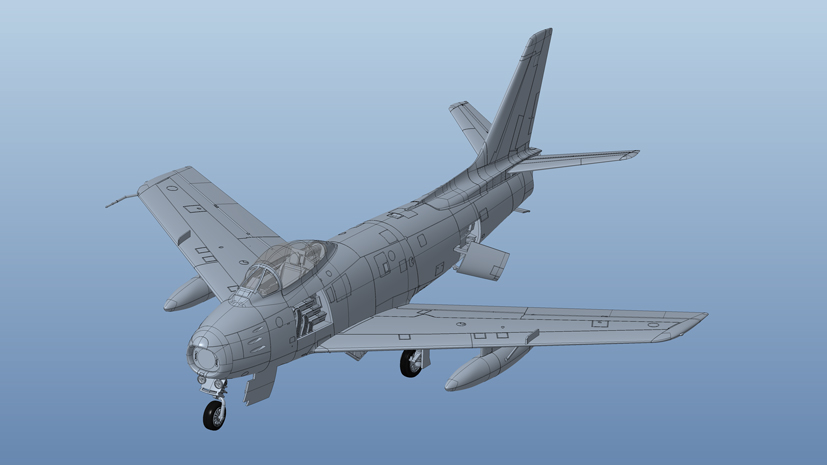
Another area of any new kit design which can always be relied upon to throw up a few design challenges is the cockpit, both the interior and exterior detail. Modern manufacturing techniques allow for much finer detail to be incorporated into the design of a new model kit, particularly when working in these slightly larger scales. This means that a designer will have to pay particular attention to areas of the kit which may be clearly visible to the modeller during construction of the kit, but only partially visible once it has been built. The cockpit interior is very much a point in case and when working in 1/48th scale, he can certainly not get away with producing generic aircraft control panels and will need to faithfully replicate the pilot’s office.
In the case of the Oslo Museum’s Sabre, the placement of a pilot mannequin in the cockpit certainly did not help Tom in this regard, either during the initial scan, nor during his follow up research visit, but this was nothing he wasn’t able to overcome relatively easily. During our discussions with Tom, it was also interesting to hear how there are usually several occasions during the design process of a new kit where something you are currently working on highlights a potential issue from an earlier phase of the design, something you will have to go back to and revisit. All this work is crucial in ensuring the new model kit is as accurate as possible, whilst at the same time being an enjoyable build project for the modeller, but will require every ounce of the designer’s skill and experience to achieve.
With regard to the new 1/48th scale Canadair Sabre Mk.4, Tom spent five extremely busy months from project acceptance to tooling quote stage and even this would still leave him with much work to do. Tooling checks, sample inspection, build and instruction checks would all still need to be completed, even though he will have already moved on to his next ‘top secret’ Airfix project.

After joining NATO in 1949, Canada were forced to consider both an upgrade and expansion of their existing Air Force capabilities, including the selection of a new fighter aircraft. The most appropriate aircraft to fulfil this role was the American built Sabre, however, the Canadian public were not keen on their military simply buying another US built aircraft and would prefer it if a British designed an built type could be precured. As a compromise, the Canadian military eventually did go with the Sabre, but a licence built Canadian version of the aircraft and after the very first aircraft had been built using exclusively US manufactured components, the next production run was made up of aircraft which were 85% Canadian produced, powered by engines which were entirely produced in the country.
As Cold War tensions intensified during the early 1950s, the RAF were desperately awaiting delivery of their first swept wing jet fighter designs to replace the Meteors and Vampires which were still facing the threat of the latest Eastern Bloc aircraft. With Britain’s indigenously produced Supermarine Swift and Hawker Hunter fighters suffering protracted development delays, the RAF decided to procure hundreds of Canadian built Sabre fighters as something of a stop-gap exercise, to equip their squadron’s based in Germany. Britain were loaned three Sabre Mk.2s in October 1952, aircraft which would be used to prepare the ground for a much larger delivery of 428 Mk.4 variants, which arrived over a twelve month period from December 1952.
The first RAF Squadron to receive the Canadian Sabre Mk.4s was No.66 Squadron and whilst they and No.92 Squadron would go on to operate the type from bases in the UK, the vast majority of these aircraft would equip ten further squadrons in Germany, forming the backbone of the RAF’s NATO fighter commitment during that volatile period. Proving to be much more than a stop-gap fighter, the Canadian built Sabres of the Royal Air Force were also the only swept wing fighters available for the defence of Western Europe, during their operational time in Germany.
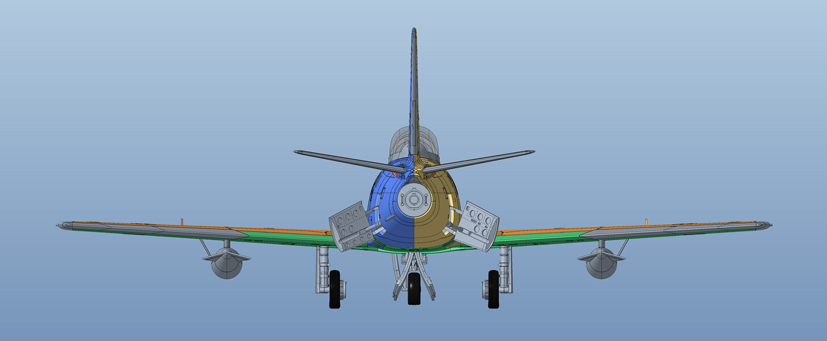
Final selection of development images from Tom’s latest model masterpiece. In this scale, the iconic Sabre is going to look quite magnificent

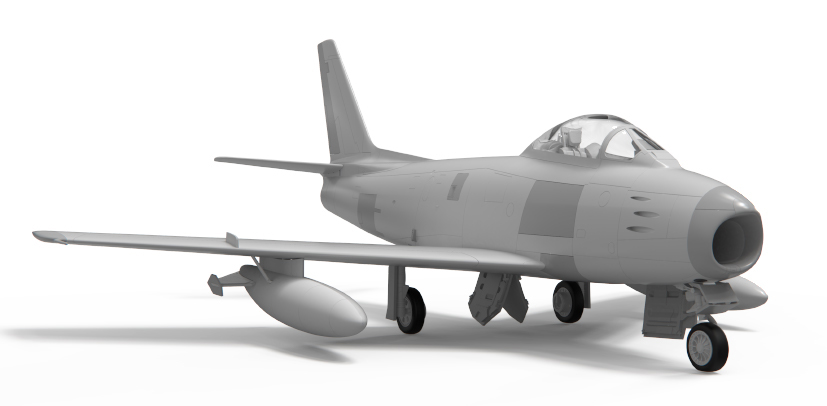
Ultimately, the RAF only operated the Sabre Mk.4 for a relatively short period and by the end of June 1956, all of the RAF’s machines based in Germany had been replaced by Hawker Hunters. Many of the former RAF Sabres went on to be transferred to other European air forces, with Italy (180 aircraft) and Yugoslavia (121 Aircraft) being the most notable beneficiaries.
The North American (Canadair) Sabre is undoubtedly one of the world’s most successful post war jet fighters and in this new larger scale, will look absolutely magnificent in our display cabinets, especially when wearing the camouflage markings of the Royal Air Force. This new model is scheduled for a winter 2020 release, however, it remains to be seen how the current worldwide restrictions will impact on production and delivery schedules. We will certainly keep readers fully updated on this situation, as well as bringing you further details from this exciting new project in forthcoming editions of the blog.
We would like to sincerely thank Tom Alderman for his help with the production of this feature and not least for supplying all the images we have been fortunate enough to be able to use – they certainly took quite some time to download!

With many thousands of modellers currently finding themselves spending much more time at their respective workbenches than usual, the New Arrivals section of the Airfix website has been taking something of a web battering of late, as people search for a suitable next project to keep them occupied in these unusual times. It you currently find yourself looking for a unique and particularly appealing new modelling project, we might just have the kit for you – a 1/72nd scale example of arguably the most distinctive RAF jet of the post war years.
McDonnell Douglas Phantom FG.1 XV582 ‘Black Mike’ made its first flight in early 1969 and was delivered to the Royal Air Force in May of the same year. In a service career which would span almost 23 years, XV582 spent time in the colours of Nos 43 and 111 fighter Squadron’s, as well as with No.228 OCU – indeed, the aircraft would earn the notoriety of being the only FG.1 variant to serve with an Operational Conversion Unit and the first airframe to exceed 5000 flying hours. An aircraft which regularly appeared to be in the aviation headlines, XV582 was also used in the record breaking ‘Lands’ End to John O’Groats Run’ on 1st April 1988, when the aircraft covered the 590 mile distance in just 46 minutes and 44 seconds, posting an impressive average speed of over 757 mph.
The fateful decision which ensured McDonnell Douglas Phantom FG.1 XV582 would go on to become one of the most famous jet powered aircraft to see RAF service occurred in the late 1980s, when she was selected as the aviation canvas for a striking squadron commemoration for the Leuchars based No.111 ‘Treble One’ Squadron. Intended as a high-profile static tribute to the illustrious history of this famous Royal Air Force Squadron and specifically to mark the period when the squadron operated large formations of both Hawker Hunters (The Black Arrows) and later, English Electric Lightnings during Britain’s classic jet era, XV582 was given a striking gloss black paint scheme and further embellished with the famous yellow squadron markings of No.111 Sqn. ‘The Tremblers’.
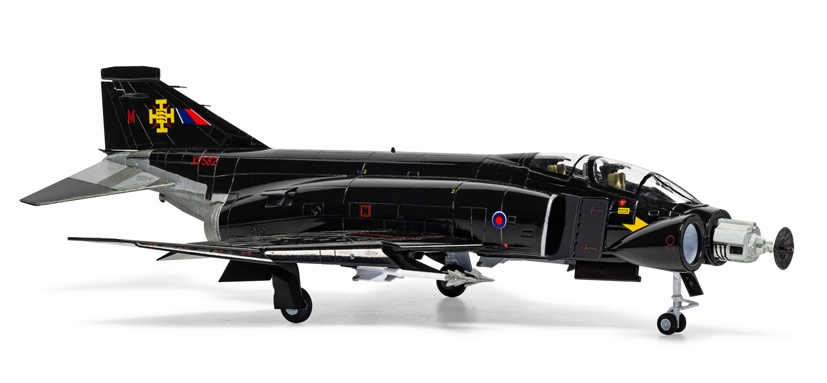
Has a plastic kit ever looked so good? The British variant of the McDonnell Douglas Phantom is an irresistible modelling subject at the best of times, but when combined with these stunning markings, it is a build project just waiting to happen
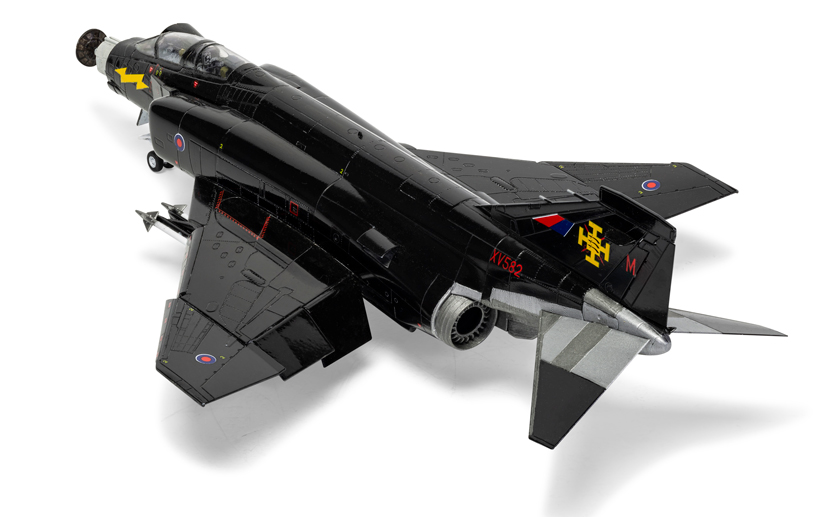

Historically, this airframe was selected for this role at random and specifically because its extensive service life determined that she had been categorised as a limited fatigue life remaining Phantom, with the original intention being that this striking tribute would only be a short-term arrangement for the squadron’s commemorative event. Despite this, it is not difficult to see how the sight of this beautifully presented black Phantom was to be the cause of so much interest, not only amongst aviation enthusiasts, but also amongst serving RAF personnel. McDonnell Douglas Phantom FG.1 XV582 was now not only one of the most distinctive individual aircraft ever to see RAF service, but one everybody with the opportunity to do so wanted to fly.
Her new found popularity dictated that although initially only intended for static display duties, the aircraft would continue to be flown for a time, resplendent in this beautiful scheme, not only serving to mark the history of its parent squadron, but also the service career of the British Phantom force. As the aircraft retained its ‘M for Mike’ code, it was not long before she attracted the rather predictable ‘Black Mike’ tag, a name which immediately identifies this aircraft and one which marks XV582 as arguably the most famous of Britain’s Phantoms. Indeed, even in retirement, ‘Black Mike’ has continued to be considered something of a British aviation icon, the star of many an Airshow static display, in addition to several specially arranged photo shoot events.
Cared for by a dedicated team of volunteers, ‘Black Mike’ is maintained in pristine condition and is currently stored at RAF St Athan in South Wales. As the latest release from our hugely popular 1/72nd scale Phantom kit includes decal options to finish the model in these very markings, this may just be the lockdown modelling project to raise our spirits just a little. McDonnell Douglas Phantom FG.1 RAF (A06019) is available now.
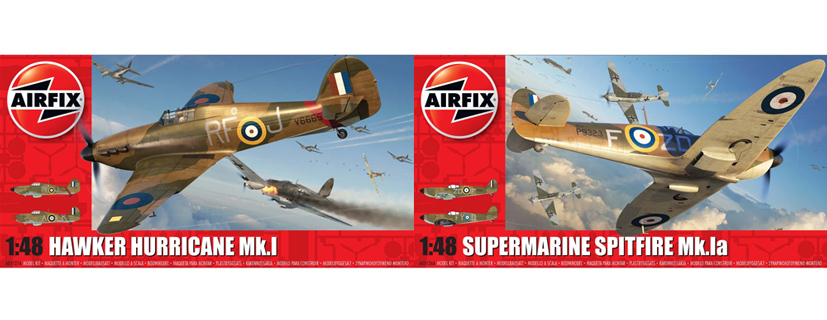
Returning to the subject of new kit arrivals for just a moment, we are pleased to report the release of three hugely popular models which featured heavily in recent editions of Workbench. With everything that the nation is being forced to endure at this present time, it is quite understandable that this year’s 80th anniversary commemorations of the Battle of Britain have slipped well down the order of priorities, however, even if the 2020 Airshow season will be unable to effectively mark the occasion, that doesn’t mean that modellers will be forced to follow suit.
With a number of kit releases planned to make our own plastic tribute to Churchill’s famous ‘Few’ who overcame overwhelming odds to prevent an invasion of the British Isles during the summer of 1940, this years blog schedule has included features detailing the scheme options to be included with two 1/48th scale kit reissues intended to mark this anniversary. Hawker Hurricane Mk.I A05127A builds into a fine representation of the aircraft which has always been in the shadows of its more famous fighting hangar mate, even though it was to make the most telling contribution to the RAF’s ultimate victory. Including decal options for a No.303 Polish Squadron aircraft flown by Sgt. Tadeusz Andruszkow and a rather famous machine which was flown by Flt. Lt. Ian Richard (Widge) Gleed, either option would make a fitting tribute to the legacy of this magnificent fighter.
No self-respecting Battle of Britain tribute could be made without including the indomitable Supermarine Spitfire, one of the most famous fighting aeroplanes of all time and in the eyes of many people, Britain’s physical and spiritual saviour during the summer of 1940. Supermarine Spitfire Mk.1 A05126A is the latest release from what must be considered one of our most popular toolings in this scale, a kit which sells out almost immediately every time it is released. This latest Battle of Britain release will be no exception and includes two appealing scheme and decal options, the first being an aircraft flown by Sergeant Arthur William Peter Spears of RAF No.222 Squadron, who operated from Hornchurch during the height of the battle and a second machine which wore the colours of No.611 (West Lancashire) Squadron at Duxford, during the period known as the ‘Phoney War’.
Both of these superb kits build into accurate and particularly impressive representations of Britain’s most famous WWII fighter pairing and they are both available now.
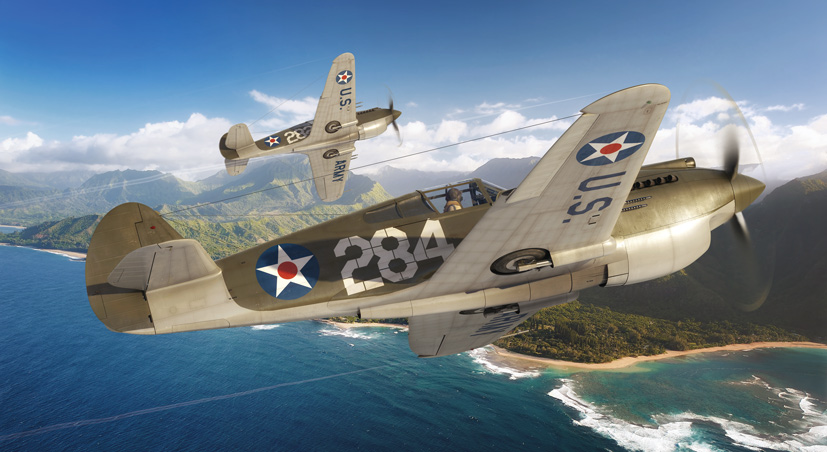
The final kit in this new arrival trilogy is proof that the old adage ‘good things come in small packages’ also extends to the model kit world. Another recent blog star which has been causing quite a stir over the past few weeks, Curtiss P-40B Warhawk A01003B includes decal options which make this an almost irresistible choice for modellers, as it is a representation of an aircraft which has both impressive wartime and Airshow provenance.
The aircraft covered by this release was in a hangar undergoing maintenance during the infamous Pearl Harbor attack in December 1941, which is probably the reason why it survived. Many years later, it was the subject of a painstaking restoration project and when it took to the air once more in January 2007, it became the only airworthy Curtiss P-40B Warhawk in the world and significantly, the only surviving airworthy American fighter from the Pearl Harbor raid. Spending some time in the UK as part of the Fighter Collection at Duxford, this historic aircraft captivated thousands of people at their regular Airshow events, as every time it displayed, enthusiasts knew they were admiring a unique piece of aviation history.
Curtiss P-40B ‘White 284’ may now be back in the US where she belongs, but for anyone who was lucky enough to see this magnificent aircraft fly, this latest kit release will surely bring back some very happy memories indeed. Priced at an attractive £6.99, this might just be one of those appealing kits to place before the kids and say, ‘Have a go at this’ and whilst they are building it, regale them with tales of how you saw this Pearl Harbor veteran blasting around the skies of Cambridgeshire.
All three of the magnificent new releases are available now.
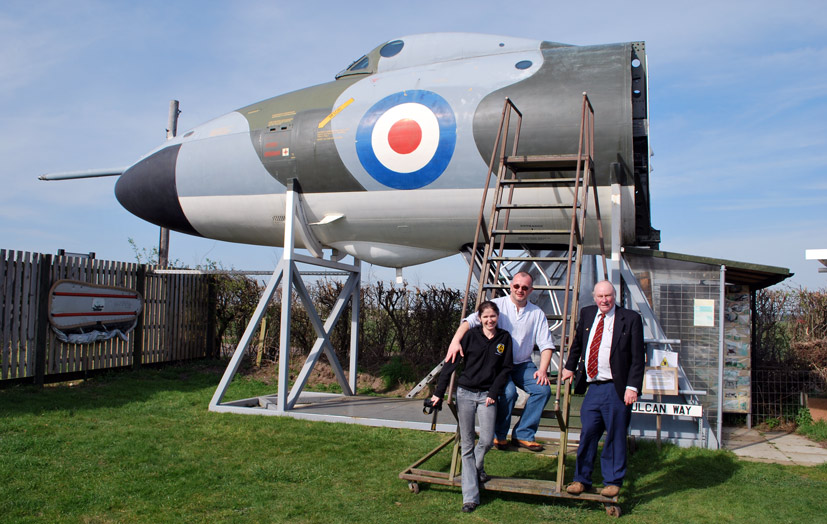
A source of inspiration, the Avro Vulcan front end section on display at Bournemouth Aviation Museum gave Phill Jones the idea for an unusual recent model build
Sometimes, it has to be said that the modelling community does not give itself the credit it deserves. You lot really are a talented bunch and the standard of modelling skill which is regularly on display at events up and down the country is quite astounding – in fact, modelling shoud surely be classed as a form of art and there is absolutely no doubt that there are plenty of extremely accomplished model artists out there.
Although sheer modelling skill will always attract the majority of the admiring plaudits, sometimes it is the imagination and creativity of a build which captivates those lucky enough to view it and those talents were very much in evidence with some recent build images which were posted on an enthusiast social media site – we simply had to investigate further.
When admiring a particularly impressive model build, it is always interesting to find out where the inspiration behind the original idea came from. The answers you receive can vary from looking at a particularly interesting historical photograph, something which was found in a reference book, or in many cases, a personal or family connection to the subject itself, but whatever that inspiration might have been, it can drive a modeller on to produce something really special, a build which impresses everyone who sees it.
That was certainly the case when we saw pictures of an unusual build completed by Phill Jones recently, one which took one of our 1/72nd scale Avro Vulcan kits and … well, butchered it! We were fortunate enough to speak to Phill about the project and he told us that he had a long association and quite possibly an infatuation with the Avro Vulcan. Joining the Royal Air Force before he was 18 years old, Phill became a Police dog handler and as part of his duties, spent many a happy hour guarding Vulcans. He told us of an occasion where he was stationed in Cyprus and was left to guard two aircraft pans full of Vulcans, sixteen aircraft in all – what a magnificent sight this must have been.
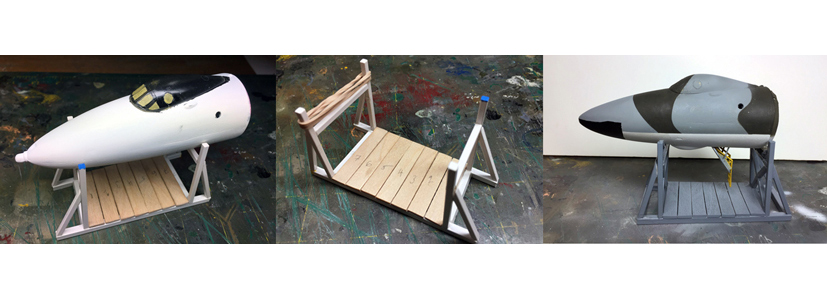
A montage of images which were supplied by Phill during the various stages of this interesting build project
He also told us that on the odd occasion, members of the RAF Police may (or may not) have written the odd message on the undercarriage doors of Vulcans which would be read and further embellished by their colleagues at other RAF stations around the world.
When coming out of the force, Phill continued his Vulcan association by volunteering to help with Vulcan to the Sky fund raising, manning the sales stand on several occasions, particularly at events around his home on the south coast. When XH558 was finally grounded, much to the dismay of Vulcan fanatics everywhere, Phill found himself in need of another Vulcan related project and found just what he needed in the form of Vulcan XH537 cockpit section at Bournemouth Aviation Museum. Once again, he volunteered his time to help maintain this much loved exhibit at what is his local museum site.
Indeed, Avro Vulcan B.2(MRR) XH537 would serve as inspiration for Phill’s latest modelling project, but not finishing the model as the aircraft might have appeared during her service life, but in her current role as a popular museum exhibit. Clearly, this was something of a radical decision and would ensure that Phill’s spares box would be receiving plenty of additional plastic as this build progressed. The majority of the kit components would actually be surplus to requirements, but the build would certainly involve the construction of some scratch built items, as well as a suitable diorama base, if the model was to be an accurate representation of this popular museum exhibit.

The build image which had us chasing Phill Jones for details. It was interesting to get the story behind this unusual project and to find out why the Avro Vulcan has been such an important aircraft in the life of this model’s creator
The Vulcan nose section of the build was well on the way, before measurements could be taken for the scratch built component parts of the support trestle could planned, a feature which was central to the overall appearance and accuracy of the project. With a suitable grass diorama base also planned, everything was finished off with a representation of the ‘Vulcan Way’ sign, which can be seen in the main image above. Phill has managed to produce a really interesting modelling project, one which is definitely just that little bit different, as well as featuring one of the much-loved Vulcans in his life, even if it is only part of one.
We would like to thank Phill for spending the time to discuss his build with us and for allowing us to use the fantastic pictures featured above. We look forward to seeing more of his modelling talents in the future and hope that the release of our new Vulcan tooling later in the year will inspire a couple more Vulcan builds. For information about the subject of this project, please use this Bournemouth Aviation Museum link.
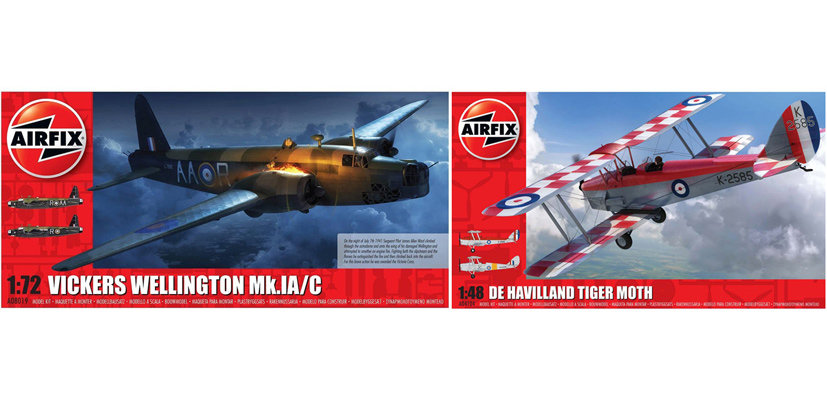
We bring this latest edition of Workbench to a close by announcing the lucky winner of our latest competition and extending our grateful thanks to everyone who took the time to enter. We know that everyone has much more serious matters on their minds at the present time, however, the response to the competition announced in the previous edition of our blog was nothing short of spectacular and thousands of you took the opportunity to register your interest in winning a Wellington and Tiger Moth kit. Only hours after the blog was posted, we had approaching 2000 entries and the numbers continued to increase from there – it’s all quite humbling really.
So, without further ado, our lucky winner, who was selected at random from the list of correct entries, was Andrea Clowes … many congratulations to you. An email has already been sent to Andrea and following receipt of her address details, we will arrange for the kits to be sent out. We will ask our wonderful Assistant Brand Manager Sally if she could see her way to letting us have a further prize stash and will include another competition in the next edition of our blog.
We are afraid that’s all we have for you in this latest edition of Workbench, however, we will be back as usual in two weeks’ time with a further selection of Airfix modelling delights for your enjoyment. If you have any suggestions for subjects you would like to see covered in a future edition, please use this workbench@airfix.com link to contact us.
In between new editions of our blog, the Airfix conversation continues over on our Airfix Forum Worbench thread, with further discussions taking place on both the official Airfix Facebook page and the Airfix Twitter channel - please do get involved in the discussions and let us know what you think about Workbench.
Whenever you decide to visit, the Airfix website is always the place to be for all the latest model availability information, previous editions of our blog, a selection of modelling tips and much more.
The next edition of Workbench is due to be published on Friday 1st May, when we will have more interesting features from the world of modelling.
On behalf of the entire Workbench team, thank you for your continued support our Airfix blog.
The Airfix Workbench Team
© Hornby Hobbies Ltd. All rights reserved.